SMS (Short Message Service) is a feature in PBXware that enables users to send and receive messages in order to achieve faster communication. It has become a globally accepted communication channel and an effective way to deliver information in a matter of seconds due to its simplicity and precision. SMS implementation in PBXware allows users to communicate efficiently and have their messages at their disposal at anytime.
¶ Numbers
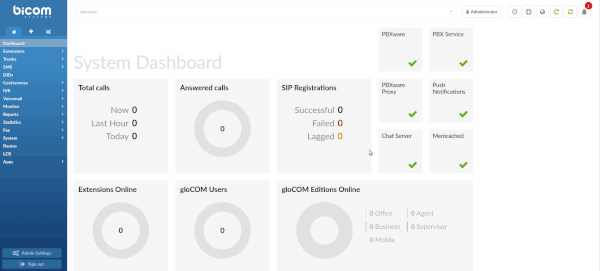
The Numbers section allows users to add numbers to the system and assign them to specific Extensions. From this section, it is possible to manage the configuration of numbers by editing or deleting it.
Numbers can be added in two ways:
- By uploading a CSV file that is either created by using the PBXware's CSV template or the provider's CSV template.
- By adding the numbers manually.
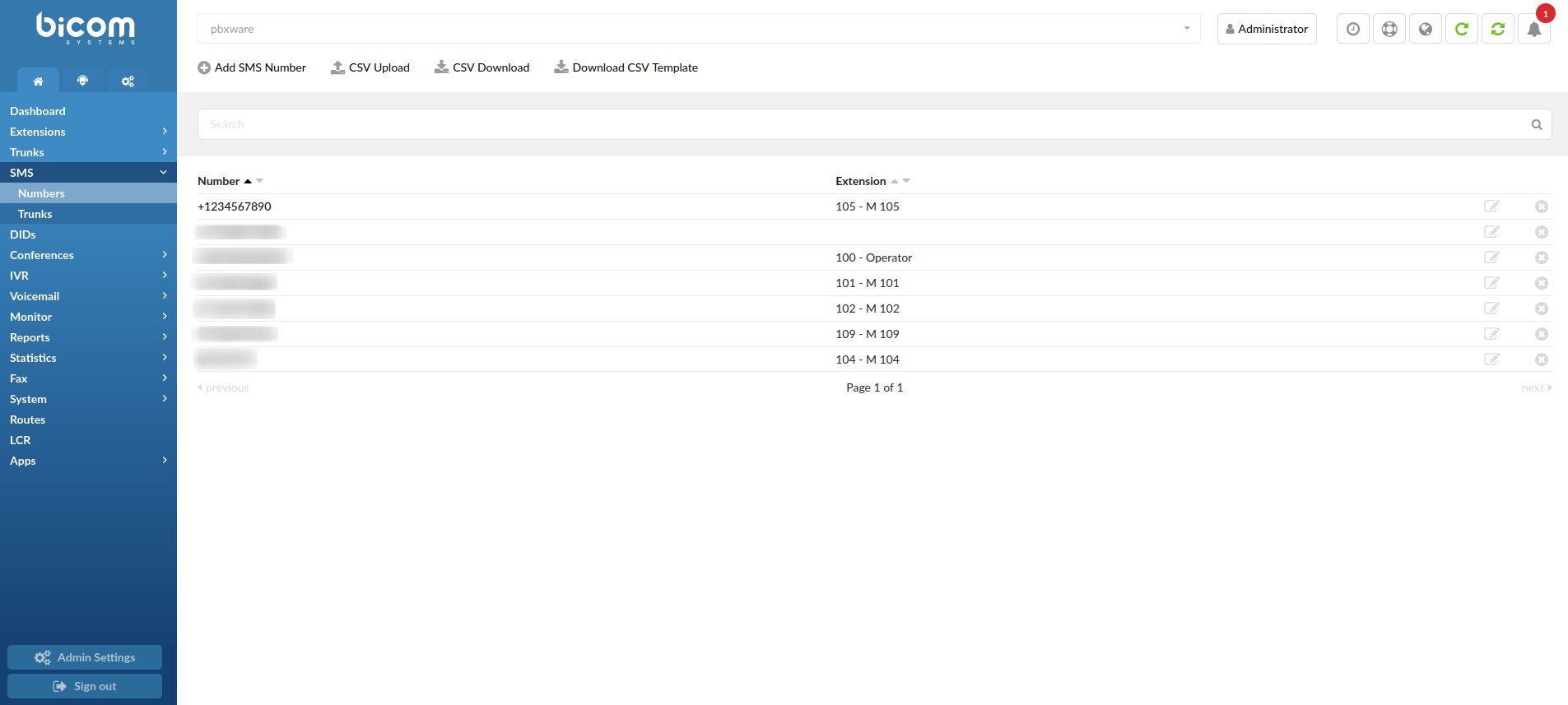
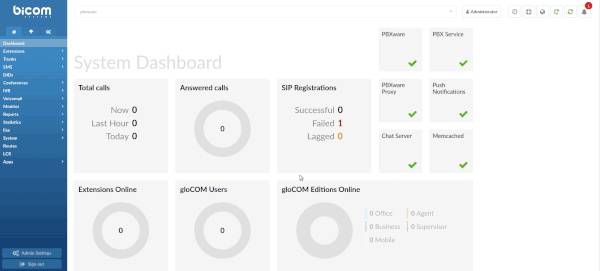

Click this button to add a new SMS number.
(Button)

Click this button to upload a CSV file.
(Button)
NOTE: CSV files can be uploaded by using one of the two following templates:
PBXware's CSV Template:
In order for this template to be successfully uploaded, a user needs to populate the following fields: '
sms_number'
and '
extension'
.
Provider's CSV Template:
If this template is used (e.g. Telnyx's), the CSV file downloaded from the Telynx website already
contains
all the necessary data
, so the next step would be just to upload the CSV file.
Additionally, since the SMS feature allows for various CSV upload methods, certain restrictions exist in order to ensure data protection and provide users with supplementary information regarding the software operations. Therefore, once a user uploads a desired CSV file, s(he) will be presented with this messages regarding the upload procedure:

This CSV message will appear after the CSV file has been successfully uploaded to the system. The further explanation shows that there were three numbers in the CSV file and all three numbers were imported. Additionally, no numbers were skipped, which shows that these numbers are nowhere to be found on the system. In case the user accidentally adds the already existing number, the number that was previously on the system will be deleted and added again through this upload, which ensures no data loss.

Click this button to download a CSV file.
NOTE: This CSV file contains the data displayed on the 'Numbers' list. It can be used for faster management of numbers and Extensions on the system.
(Button)

Click this button to download a CSV template.
NOTE: In order to successfully manage the CSV file, the following should be done:
1. Download an empty CSV template
2. Populate the fields with specific information
3. Save the settings
4. Upload it by using the 'CSV Upload' button
6. Data is now displayed on the list.
(Button)

- Search
Enter a piece of information and press Enter to have results filtered accordingly
(E.g. 101)
[(0-9)]
NOTE: Users can search entries by using 'Number', 'Extension', and 'Extension Name'.
- Number
Displays a Number added to the system
(E.g. +1234567890)
(Display)
NOTE: Hovering the mouse over the Number section and clicking it will prompt users to the Add SMS Number window. A user cannot edit numbers from there but Extensions. For more information on this, click the link provided.
- Extension
Displays an Extension and Extension Name to which the number has been previously assigned to
(E.g. 101 - M 101)
(Display)
 Click this button to edit the SMS Number configuration.
Click this button to edit the SMS Number configuration.
NOTE: Upon clicking this button, users will be prompted to the Add SMS Number window where they can edit Extensions accordingly. Please note that the numbers cannot be edited from here. For more information on this, click the link provided.

If a user decides to edit the configuration and assign the existing number to another Extension, the following warning message will appear: "Extension is already in use. Do you want to remove it from another number and assign it to this one?". If users click the Cancel button, then the action will be abandoned. On the contrary, if OK is clicked, the number will be assigned to a different Extension and deleted from the old one. Please refer to the screenshot.
(Button)
 Click this button to delete the SMS Number configuration.
Click this button to delete the SMS Number configuration.

NOTE: Upon clicking the button, the following warning message will appear: "Are you sure you want to delete XYZ*?"*. If users click the Cancel button, then the action will be abandoned. On the contrary, if OK is clicked, the selected configuration will be deleted.
For more information, please refer to the screenshot.
(Button)
¶ Add SMS Number

NOTE: The 'Number' field is required and it has to be populated. Not defining that field will result in the warning messages being shown. Please refer to the screenshot.

¶ General
- Number
Enter the number to which SMS messages will be sent
(E.g. +1234567890)
([0-9])

NOTE: If a user tries adding the number that already exists on the system, the following warning message will appear: "Number is already in use!". Please refer to the screenshot.
NOTE: Please note that the number has to be in the E.164 format.
- Extension
Assign this number to a specific Extension
(E.g. 101 - Test101)
(Select box)

NOTE: Since this is not a required field, it can be left empty and seen in the list as such. In case a user tries selecting the Extension to which a number has been assigned previously, the following warning message will appear: "Extension is already in use!". Please refer to the screenshot.
The example below represents how the configuration should look like after being completed and saved:

NOTE: Once users save the settings, editing a number is not possible. However, if there is an input mistake, the following has to be done:
1. Click Go back,
2. Delete the configuration from the list by clicking Delete,
3. Add the number again,
4. Assign an Extension to it and click Save.
The SMS feature allows for DIDs from PBXware to be entered in this field as well.
NOTE: These steps should be followed in case a user has already added a DID and populated all other required fields. Once that is completed, a user should do the following:
1. Go to the 'DIDs' section
2. Find the DID to be used for SMS
3. Hover over the DID and click it in order to be prompted to a different window
4. Click 'Show Advanced options'
5. Assign a desired DID to a specific Extension
6. Set the 'Enabled SMS' to 'Yes'
7. Click Save.
Assuming the user completed the procedure as described above, s(he) needs to do the following:
1. Go to the 'Numbers' section
2. Check whether the configuration is set up correctly
After adding a DID from PBXware, this is how the list on the 'Numbers' section should look like. As it can be seen, PBXware offers an easy way to monitor which DIDs have been added from the system. Such numbers have no 'Edit' or 'Delete' options due to the fact that they have been added to this list in a different way, (i.e. through the DIDs section on PBXware).
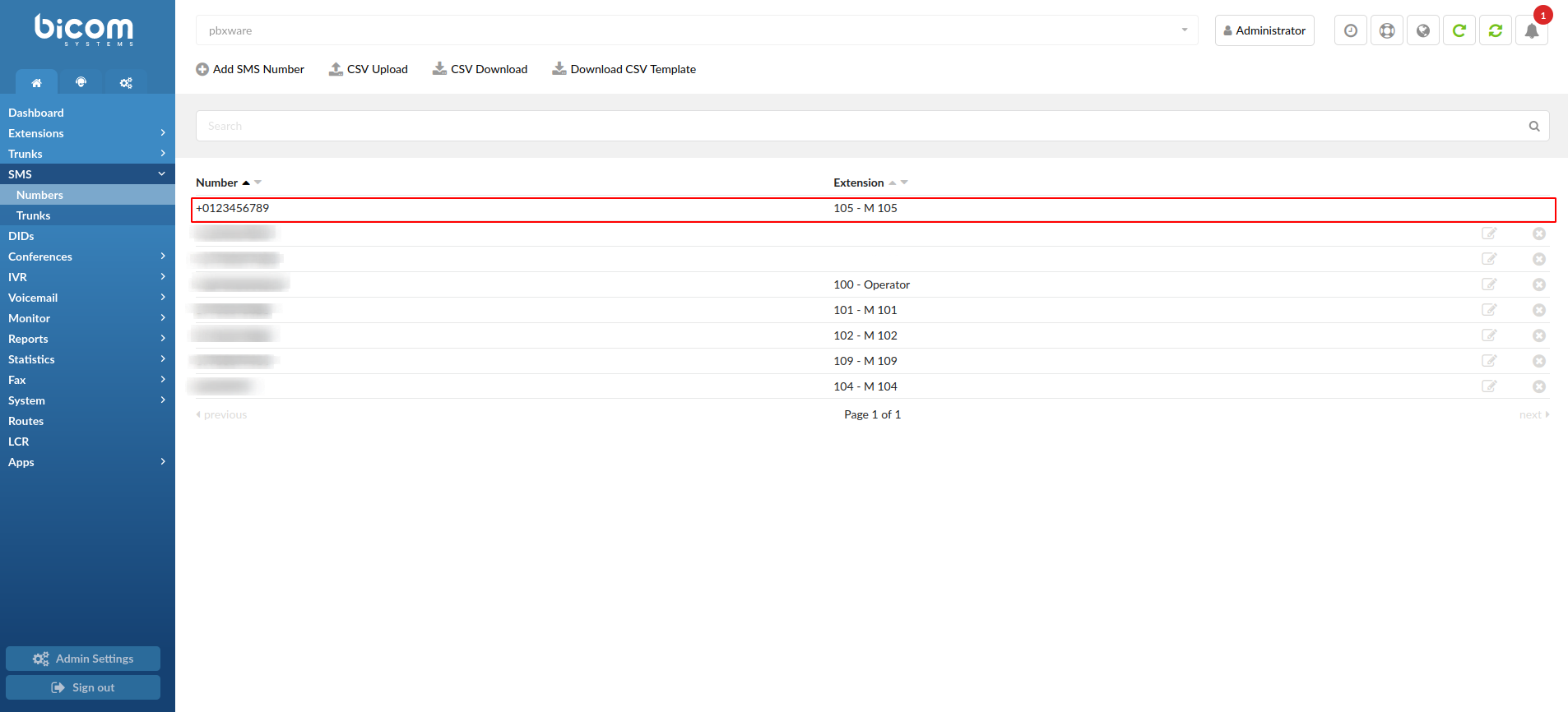
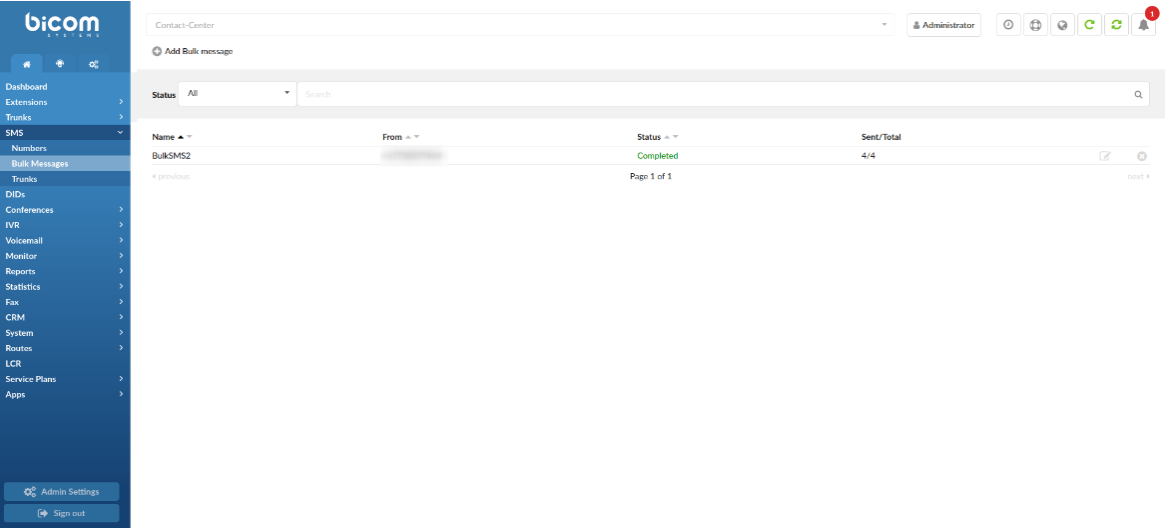
The 'Bulk Messages' section allows users to send bulk SMS messages. By using this feature, users can send important information to a larger number of people. Apart from adding Bulk SMS messages through the GUI, users can easily upload their data by using CSV files or filter their Bulk SMS messages by status. They can start new Bulk messages or stop the active ones. There is also a possibility to restart them.
Users can utilize the 'Search' option and filter their data accordingly. Please refer to the drop-down list:
- All
- Active
- Not Active
- Paused
- Stopped
- Completed
This page displays the following information:
- Name
Displays the name of the Bulk message
(E.g. BulkSMS2)
(Display)
- From
Displays the number/alphanumeric the Bulk message was sent from
(E.g. +1234567890)
(Display)
- Status
Displays the status
(E.g. Completed)
(Display)
- Sent/Total
Displays the number of sent messages and the total amount of numbers that the message should be sent to
(E.g. 4/4)
(Display)
NOTE: 'Sent' refers to the number of successfully sent messages. 'Total' refers to the total amount of numbers uploaded via CSV file. For example, '4/4' means that there were four numbers in the CSV file and all four messages were successfully sent to these numbers.
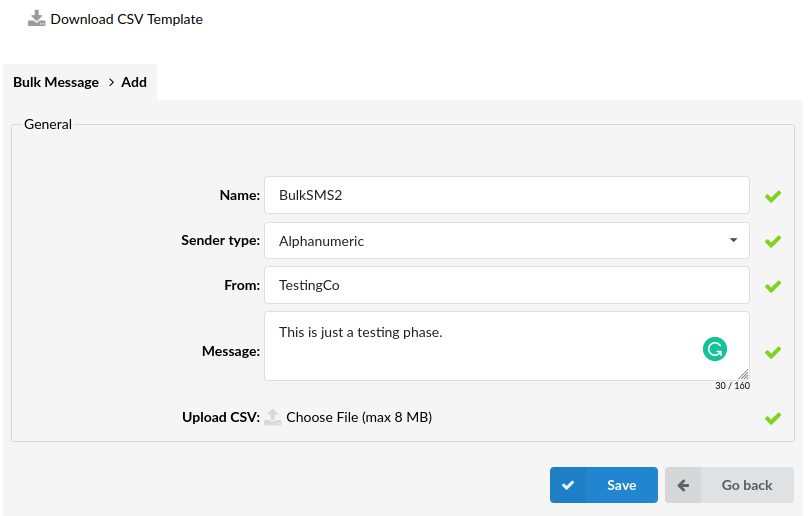
Click this button to add a Bulk message.

(Button)
¶ Add Bulk Messages
- Name
Enter a name of a Bulk message
(E.g. BulkSMS2)
([a-z][0-9])

NOTE: This is a required field. If it is not populated, the warning message will be displayed. Please refer to the screenshot.
- Sender type
Select a sender type

(E.g. Number/Alphanumeric)
(Select box)
NOTE: This is a required field. If it is not populated, the warning message will be displayed. Please refer to the screenshot.
- From
Populate the 'From' field with specific information

(E.g. TestingCo)
([a-z][0-9])
NOTE: This is a required field. If it is not populated, the warning message will be displayed. Please refer to the screenshot.
- Message
Populate the 'Message' field with specific information

(E.g. This is just a test.)
([a-z][0-9])
NOTE: This is a required field. If it is not populated, the warning message will be displayed. Please refer to the screenshot.
- Upload CSV
Click this button to upload a CSV file

(File Upload Button)
NOTE: This is a required field. If it is not uploaded properly, the warning message will be displayed. Please refer to the screenshot.
INFO: Users can upload CSV files in the following format:
| HEADERS | to_number,Name,LastName,Account | ||
| EXAMPLE | +1234567890,John,Smith,Basic+ | ||
| EXAMPLE | +1112223334,Ann,Doe,Pro+ |
NOTE: Please note that name of the 'to_number' field is required, while other column names can be custom.
After uploading the CSV file, users can create a special message in the 'Message' field by using the values from the uploaded CSV file. Please refer to the example:

These are the examples of SMS delivered:
SMS Example 1
"Dear John Smith, with number +1234567890, we want to inform you that your Basic+ account has been activated."
SMS Example 2
"Dear Ann Doe, with number +1112223334, we want to inform you that your Pro+ account has been activated."
¶ Trunks
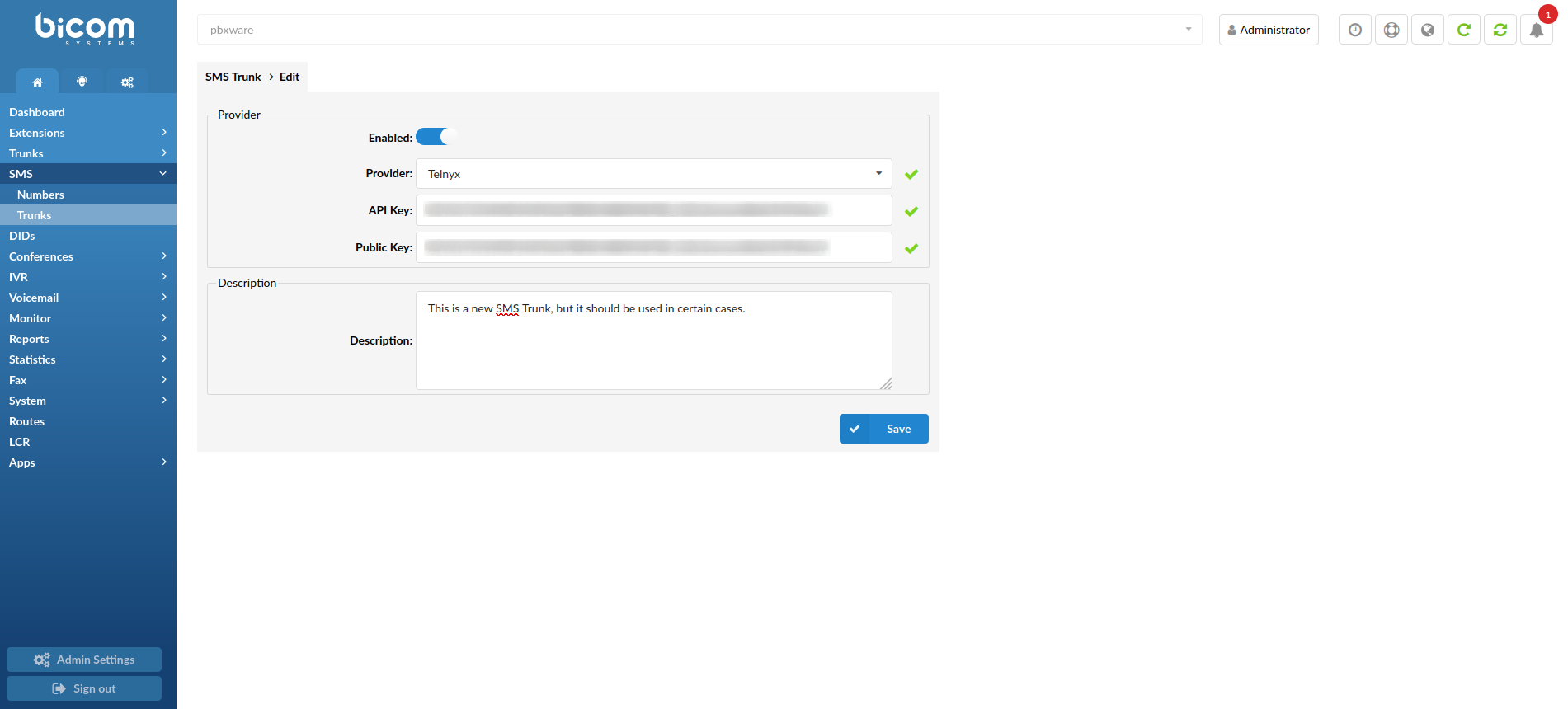
The 'Trunks' section allows users to create SMS Trunks and specify configuration details. Users can here configure a new Trunk and/or edit the existing one.
¶ SMS Trunk
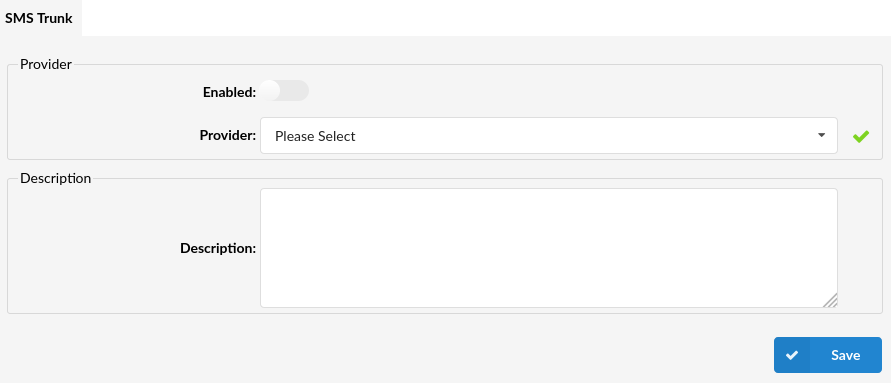
NOTE: The 'Provider' field is required. Depending on the chosen provider, the additional fields will appear that have to be populated. Not defining those fields will result in the warning messages being shown. Please refer to the screenshots.
¶ Telnyx Provider

Click this toggle button to enable the SMS service
(Toggle button)
- Provider:

Select Telnyx from the drop-down menu
(Select box)
NOTE: The provider must be selected.
- API Key:

Populate the field with a suitable API Key
(E.g. **********************************************************)
[(a-z)(0-9)]
NOTE: This field is visible when a suitable provider is selected. In order for configuration to be set up correctly, this field must not be empty.
- Public Key:

Populate the field with a suitable Public Key
(E.g. **********************************************************)
[(a-z)(0-9)]
NOTE: This field is visible when a suitable provider is selected. In order for configuration to be set up correctly, this field must not be empty.
- Messaging Profile ID:

Populate the field with a suitable Messaging Profile ID
(E.g. **********************************************************)
[(a-z)(0-9)]
NOTE: This field is visible when a suitable provider is selected. In order for configuration to be set up correctly, this field must not be empty.
The example below represents how the configuration should look like after the fields are populated:
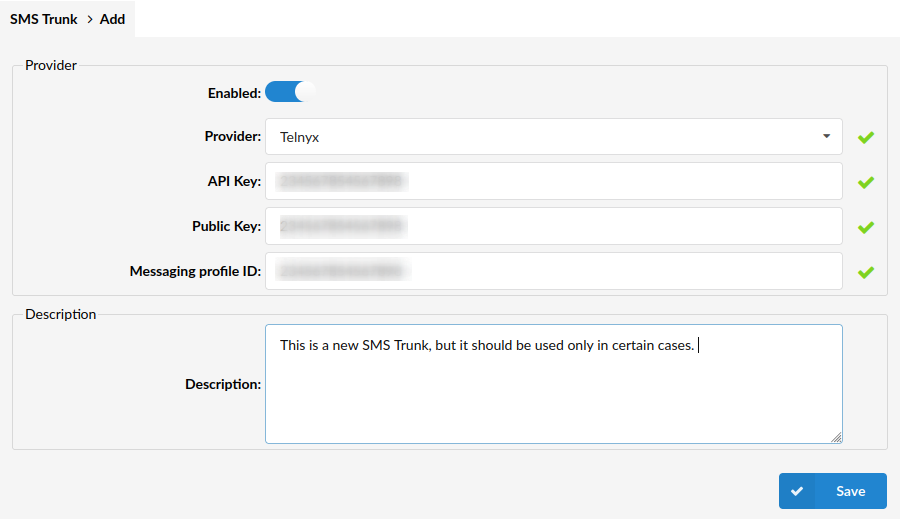
¶ Bandwidth Provider

Click this toggle button to enable the SMS service
(Toggle button)
NOTE: In order to use Bandwidth as a provider, it has to be enabled in a licence.
- Provider:

Select Bandwidth from the drop-down menu
(Select box)
NOTE: The provider must be selected.
- API Token:

Populate the field with a suitable API token
(E.g. ***************)
[(a-z)(0-9)]
NOTE: This field is visible when a suitable provider is selected. In order for configuration to be set up correctly, this field must not be empty.
- API Secret:

Populate the field with a suitable API secret
(E.g. ***************)
[(a-z)(0-9)]
NOTE: This field is visible when a suitable provider is selected. In order for configuration to be set up correctly, this field must not be empty.
- User ID:

Populate the field with a suitable User ID
(E.g. **********************************************************)
[(a-z)(0-9)]
NOTE: This field is visible when a suitable provider is selected. In order for configuration to be set up correctly, this field must not be empty.
- Application ID:

Populate the field with a suitable Application ID
(E.g. **********************************************************)
[(a-z)(0-9)]
NOTE: This field is visible when a suitable provider is selected. In order for configuration to be set up correctly, this field must not be empty.
The example below represents how the configuration should look like after the fields are populated:
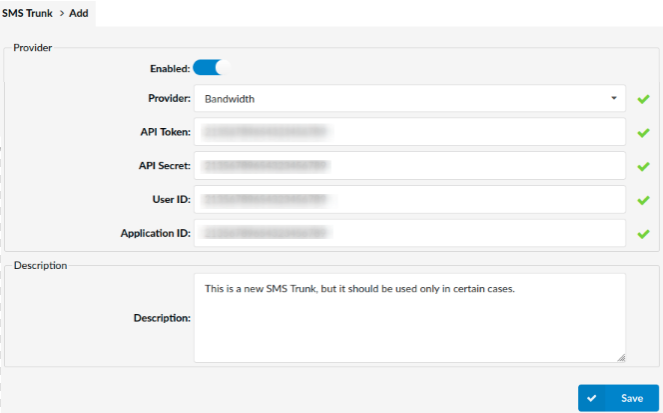
¶ Twilio Provider

Click this toggle button to enable the SMS service
(Toggle button)
NOTE: In order to use Twilio as a provider, it has to be enabled in a licence. If using the Multi Tenant Edition, Tenant Code(s) have to be provided.
- Provider:

Select Twilio from the drop-down menu
(Select box)
NOTE: The provider must be selected.
- Account SID:

Populate the field with a suitable Account SID
(E.g. **********************************)
[(a-z)(0-9)]
NOTE: This field is visible when a suitable provider is selected. In order for configuration to be set up correctly, this field must not be empty.
- Auth Token:

Populate the field with a suitable Auth Token
(E.g. ********************************)
[(a-z)(0-9)]
NOTE: This field is visible when a suitable provider is selected. In order for configuration to be set up correctly, this field must not be empty.
The example below represents how the configuration should look like after the fields are populated:
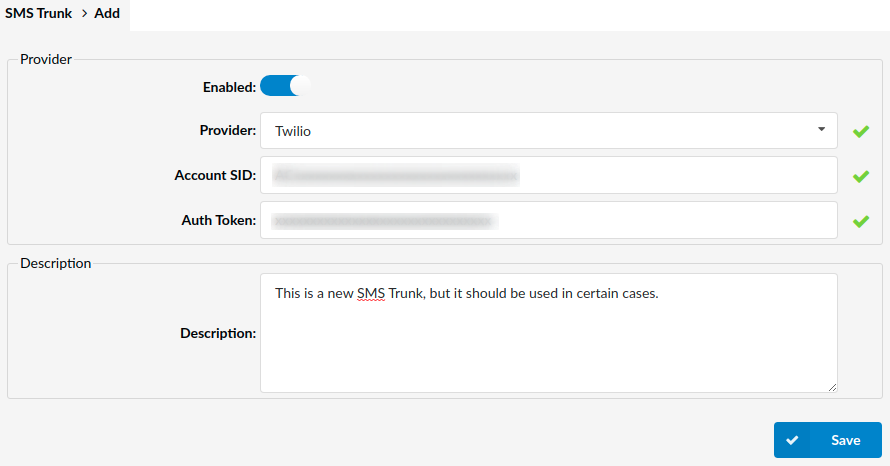
¶ Description
- Description:
Enter a suitable description regarding this Trunk.
(E.g. "This is a new SMS Trunk, but it should be used in certain cases.")
[(a-z)(0-9)]
NOTE: The description can contain any information that is necessary to differentiate this SMS Trunk from other Trunks on the system. Since this is not a required field, it can be left empty.
¶ VoIP Innovations Provider (6.6)
Click this toggle button to enable the SMS service
NOTE: In order to use VoIP Innovations as a provider, it has to be enabled in a licence. If using the Multi Tenant Edition, Tenant Code(s) have to be provided.
- Name:
Enter a name of the provider. This is relevant only for easier navigation in the GUI.
(E.g. Test)
NOTE: The name of a provider must be entered.

- Provider:
Select VoIP Innovations from the drop-down menu
NOTE: The provider must be selected.

- API Login:
Populate the field with a suitable API Login
(E.g. **********************************)
NOTE: This field is visible when a suitable provider is selected. In order for configuration to be set up correctly, this field must not be empty.

- API Secret:
Populate the field with a suitable API Login
(E.g. ********************************)
NOTE: This field is visible when a suitable provider is selected. In order for configuration to be set up correctly, this field must not be empty.

The example below represents how the configuration should look like after the fields are populated:
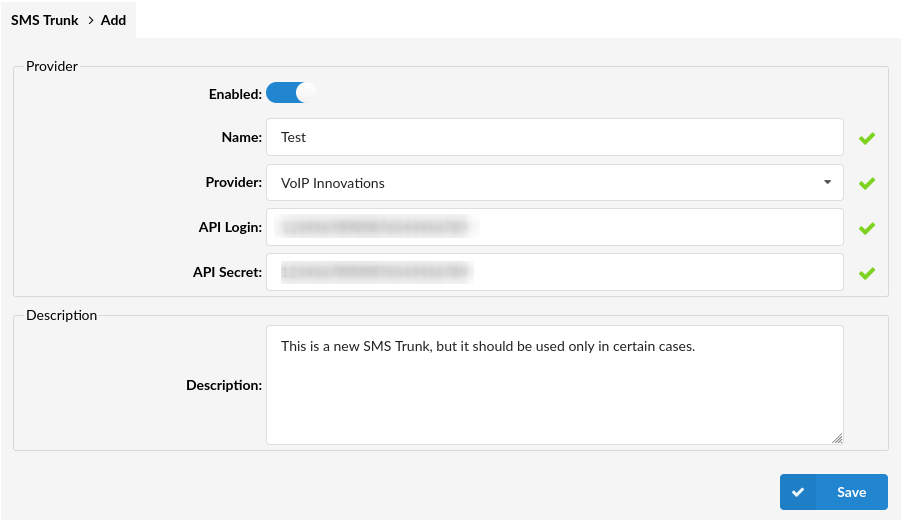
- Description
Enter a suitable description regarding this Trunk.
(E.g. "This is a new SMS Trunk, but it should be used in certain cases.")
NOTE: The description can contain any information that is necessary to differentiate this Trunk from others. Since this is not a required field, it can be left empty.
¶ OZSMS Provider (6.7)
Click this toggle button to enable the SMS service.
NOTE: To use the OZSMS with PBXware it must be enabled in your PBXware license, if this is not the case please contact your account manager.
- Name:
Enter the name of the provider. This is relevant only for easier navigation in the GUI.
(E.g. Test)
NOTE: The name of a provider must be entered.
- Provider:
Select OZSMS from the drop-down menu.
NOTE: The provider must be selected.
- API Login:
Populate the field with a suitable API Login.
(E.g. **********************************)
NOTE: This field is visible when a suitable provider is selected. It must not be empty for the configuration to be set up correctly.
- API Secret:
Populate the field with a suitable API Secret.
(E.g. ********************************)
NOTE: This field is visible when a suitable provider is selected. It must not be empty for the configuration to be set up correctly.
The example below represents how the configuration should look like after the fields are populated:
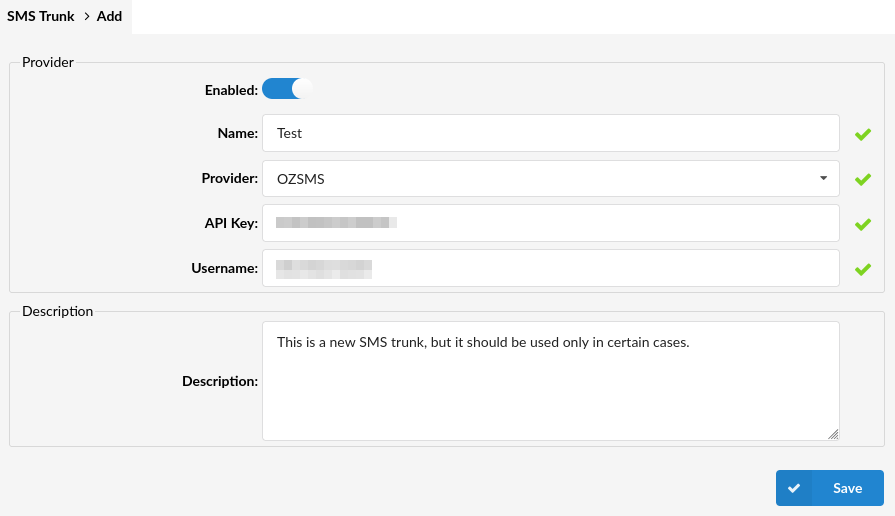
- Description
Enter a suitable description regarding this Trunk.
(E.g. "This is a new SMS Trunk, but it should be used in certain cases.")
NOTE: The description can contain information necessary to differentiate this Trunk from others. Since this is not a required field, it can be left empty.
